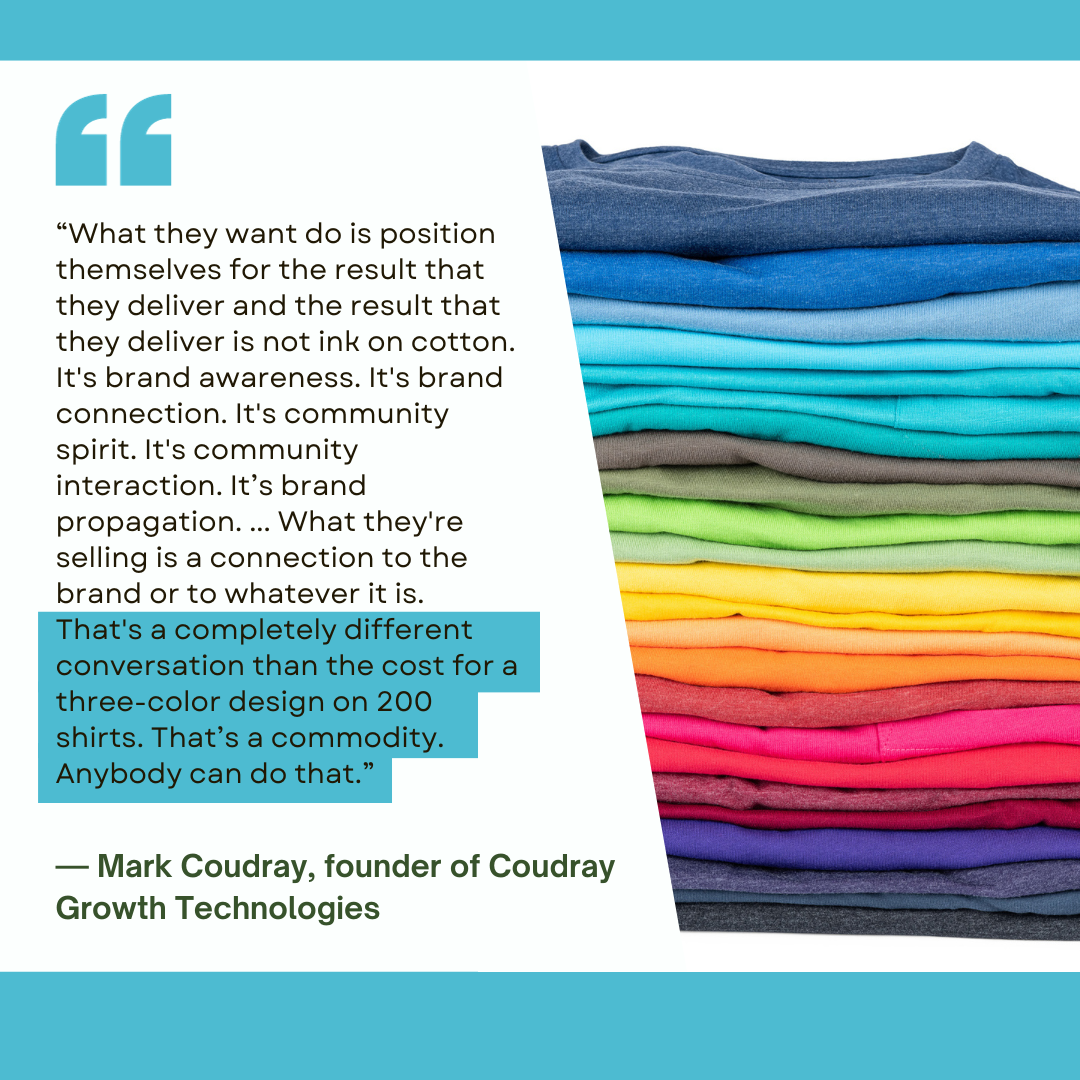The Price is Right: How to Land on Prices That Work for Your Apparel Decoration Business
Pricing and profit gurus, plus a shop, share advice for pricing apparel decoration services.

From understanding cost structure and different pricing strategies to allowing for flexibility, pricing is a nuanced piece of your business. Before we dive into the deep end of pricing methods for apparel decoration services, there are some basics to nail down.
It’s important to note that there is not a one-size-fits-all equation that works for every print business. What works for one model might not work for another, requiring businesses to know their numbers and ask their customers the right questions.
To help weed through the noise, Nick Gawreluk, the founder of Print Profit; Mark Coudray, founder of Coudray Growth Technologies; and Nikki Bowen, co-owner of Cotton Street Apparel and founder of Print Girl Mafia, share their knowledge with apparel decorators.
To kick things off, Gawreluk explains an apparel decoration business's overall cost structure and how that impacts pricing. The cost structure comprises two simple yet powerful things: fixed costs and variable costs.
“This is powerful because of the ability to demystify profitability,” Gawreluk says. “What is left over when you sell each job and subtract variable costs is the ammunition your business has to surpass monthly fixed costs and reach profitability. Selling price therefore plays a crucial role in determining your success!”
Pricing Strategies
With that motivating mindset, decorators can start to think about their pricing strategy. But first, Bowen says the first item on the list is to identify all overhead costs associated with running the business. She stores that information in a centralized location and uses it to establish a pricing matrix that accounts for all her shop’s monthly expenditures. She also uses the data to set daily sales targets for her business.
Once overhead costs are outlined, it’s time to strategize. There are excellent, good, and bad pricing strategies, and Gawreluk encourages businesses to think outside the box a bit and not feel married to any one particular pricing method. Because pricing is the most influential area of a business in determining profitability, he wants decorators to know there are levers to push and pull to alter pricing up and down.
Businesses want to get as much as the customer is willing to pay. With this top of mind, Gawreluk and Coudray share their thoughts on some of the more common pricing strategies.
Coudray says 80% of printers fall into the competitive comparison column — defining price based on another shop. It’s the scenario printers see time and time again in forums and Facebook groups. People pose questions to the masses like, “How much would you charge for XYZ?” or “Is X price too high or too low for this job?”
It’s the worst way to approach price, Coudray says, because it’s not tied to any cost structures, overhead, or a shop’s unique skills or value. “The danger with that, and this is super important, is that when you go for a price-driven strategy, the next low price wins the job.”
That means there’s no customer loyalty, and the cost of customer acquisition then rises. “And the impact to deliver on a brand-new client is almost zero profit the first time through, at least,” Coudray adds, “because now you’ve got approvals and you have to prove yourself, and they’ve got questions. There’s a lot of friction.”
The next 15%, he says, often use the second-worst model, which is the cost-plus marginal markup. While fast and efficient calculations can be enticing, Gawreluk agrees this method can be dangerous. It doesn’t consider what’s happening in the market, what the customer is willing to pay, or the shop’s time.
“Both of those literally hamstring the business profitability because it's focusing on the lowest cost in the market,” Coudray explains. “Printers think that cost is the most important factor in the decision of the buyer. But in reality, if you look at any of the pricing studies that have been done over the years, it usually falls somewhere around eight or nine on a scale of one to 10. So, it's really at the bottom. There are many other factors that are above.”
And those factors are value-based, which he says is what the remaining 5% of the market explores. Oftentimes, printers don’t understand the value they bring, whether it’s time and fast turnarounds, quality, garment knowledge, or an understanding of brand awareness. Thus, they don’t charge for that value.
“Time is the single biggest resource,” Coudray argues. “So, anything that you can do to deliver a faster result, a better result with less friction, which means less customer service, less customer interaction, and in a shorter time frame, is going to be worth money to you.”

Emphasizing that specific unique value is the key to success in a competitive market, Bowen says. Rather than chasing another shop's pricing structure, she advises them to define and sell their distinctiveness. In addition to quick turnaround time, this can be:
- Quality and expertise
- Customization and creativity
- Customer service and transparent communication
- Sustainability practices
- Printing technology and innovations
- Specialized niches
“Remember, differentiation is key in a competitive market,” Bowen reminds shop owners. “By identifying and promoting what makes your shop stand out, you can attract clients who value those specific qualities and are willing to pay for the unique benefits your shop provides.”
Getting a Baseline
While using the cost-plus or competition-based methods to create a pricing menu can be attractive, it can hurt an apparel decorating shop trying to be profitable. Yes, it can simplify quotes on the surface, but it could also mean leaving money on the table, pricing yourself out, or racing to the bottom. So, how can shops have some type of baseline pricing while also leaving wiggle room based on the client?
Although there is no silver bullet for pricing, Aaron Montgomery, founder of Our Success Group, suggests a formula that considers a shop’s unique circumstances and answers to some of the concerns laid out. The formula, which he dives into in his Pricing for Profit classes, is:
Overhead Rate / Time
+ Direct Costs
+ Profit Margin
= Price Needed
Bowen suggests checking out Printavo's pricing matrix, something she employs for her shop. The matrix aims to help shops identify their goals, costs, and more to come to a price that works specifically for their business.
Using these different methods and tools, shops can begin to create a price sheet for their different services and offerings. This is a nice starting place, but it doesn’t have to be the end-all for every job.
“We often think about a price menu as being customer-facing by default and forget that it can also be for internal use only,” Gawreluk reminds apparel decorators. “Creating a supporting playbook that guides your team in using the menu and knowing how to identify opportunities to adjust price is feasible with the right creativity and dedication.”
He says it can even be as simple as a shop owner sitting down with its sales team and classifying various customer bases into different segments (i.e., schools, bands, reunions, etc.) and giving each a supporting price strategy.
“The name of the game is optimizing each and every job that comes in to generate as much margin as possible,” Gawreluk adds.
It's also important to consider special circumstances and pricing those accordingly. In the days when Amazon has everyone wanting products now, decorators need to consider the cost associated with rush order requests. This value add-on necessitates an additional charge.

"Think carefully about the impact taking on such requests may have on your internal workflow and existing commitments, and develop a price that you believe is both justified for your efforts and in line with what customers will pay for such a premium,” Gawreluk says. “Many possibilities like this example exist, and your knowledge of the customer base is the key to identifying opportunities.”
Keeping Your Finger on the Pricing Pulse
Now armed with some solid pricing advice, it might be time to review your strategy with a fine-toothed comb. Once you’ve landed on what works for your business, don’t let it go unchecked.
“Pricing is a primary pulse of your business, check it accordingly!” Gawreluk says. “At bare minimum, a deep dive strategic pricing review at the start of each year followed by a six-month follow-up. For those with data-driven insights, there’s no reason why the team can’t assess on a monthly or quarterly basis.”
Establishing a pricing strategy that drives the day-to-day business while leaving some room for flexibility is the key, Gawreluk continues. It’s OK and encouraged to pivot from the baseline pricing sheet and address more complex clients differently.
"Look for opportunities to think outside the box based on your business performance throughout the month — capacity, availability, customer demand, etcetera,” he adds. “Pricing is both an art and a science! The future of the industry is bright for those who embrace data-driven insights and are not afraid to experiment with new pricing methods. No matter where you are in this journey, outline a few practical steps you can take in early 2024 and know the efforts will be worth your while.”
